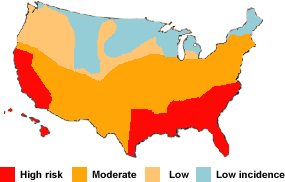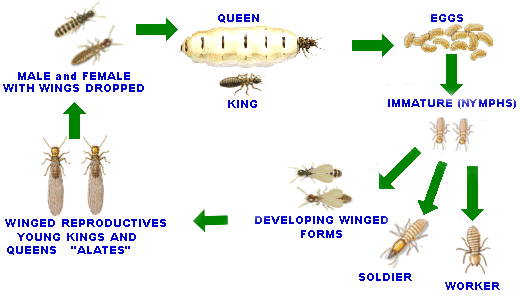Subterranean
termites are a highly destructive timber pest, causing major structural
timber damage to domestic / commercial buildings in the USA.
Recent
industry surveys suggest that most homes are at risk of a subterranean infestation
particularly in warmer more temperate climates.
Severe
termite damage to buildings is on the increase since the removal of the
long lasting soil barrier chemicals; the more common use of softwood building
and other landscaping timbers that termites find irresistible. Other important
factors include building designs, automatic watering systems, landscaping
and maintenance that encourage termite activity and/or allow hidden termite
entry and infestation into a building.
 |
Destructive Termite Risk Assessment |
Termites that live in the Ground and can eat Your house down
....
Termites are known to destroy the wall and roofing timbers of a home
within 3 months of construction.
Termites cause more damage to homes in USA than fire, floods, storms
and tempest, combined.
Termites occur throughout most states of the USA, with a high incidence
of attack in virtually all urban areas.
PLEASE NOTE: Severe termite damage to a building is not uncommon.
To compound the problem, your Home or Building Insurance Policy will
NOT cover the repair costs of any timber damage caused by termites. |
Subterranean
termites are small in size (about half the size of match-head) and soft
bodied insects. They build a central colony nest from which they construct
underground tunnels that radiate within a 100 yard radius from a central
colony nest in search of a timber (cellulose) food source.
The picture on the left shows a termite inspector examining an above ground
termite subsidiary nest built inside a wall cavity of a home.
Termites often
build such nests if moisture is allowed to regularly collects inside the wall
cavity, say from leaking pipes, shower recess, faulty plumbing, guttering,
broken roof tiles, etc. |
Termites travel in humidified mud-shelter tubes
or galleries...
The picture on the left shows a mud shelter tube that subterranean
termites have constructed over a solid object, in this case, a brick
foundation wall in the sub-floor of a cottage.
Subterranean termites
travel in these mud shelter tubes as protection from predators, sun-burn,
dehydration and to maintain a high humidity environment which is
essential for their survival.
Subterranean termites are highly secretive,
preferring to enter a building through areas inaccessible to inspection,
such as, through in-fill patios, fire heaths, expansion joints and
cracks in concrete slab (on-ground) flooring.
Subterranean termites
can pass through a 2 mm crack or an expansion joint (eating through
the rubber compound) between adjoining concrete on ground flooring.
They can also travel under parquetry and floor tiles to get to the
wall framing timbers. |
|













